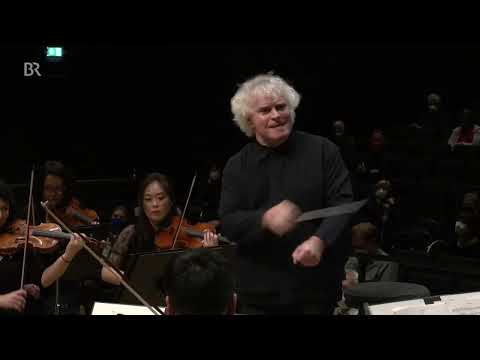
Sir Simon Rattle conducts Mahler’s Symphony No. 9

Gustav Mahler´s last complete Symphony No. 9 – stirringly and captivatingly performed by the Symphonieorchester des Bayerischen Rundfunks under the baton of its future Chief Conductor. Live recording of the memorial concert for Bernard Haitink in November 2021 in Munich at the Isarphilharmonie im Gasteig HP8. This recording is also the first 3D-Audio-release in DOLBY ATMOS of BR-KLASSIK Label!
Order online nowGustav Mahler’s Ninth Symphony, in particular, is understood as the composer’s reaction to a heart ailment that was diagnosed shortly before he wrote the first drafts in the summer of 1908. He was in deep despair, but still scarcely aware of how few years he actually had left to live. With Mahler, it was always in and through music that he tried to come to terms with his life experiences and such topics as farewell, the meaning of existence, death, redemption, life after death and love. He wrote his Ninth Symphony in Dobbiaco, in a kind of creative frenzy, between 1909 and 1910. Its premiere took place in Vienna on June 26, 1912, when the Vienna Philharmonic Orchestra performed the work under Bruno Walter. Mahler did not witness the premiere of his last completed work – he had already died on May 18, 1911.
One of the first reactions to the premiere interpreted the syncopated rhythm at the beginning of the symphony’s first of four movements as imitating the beat of an ailing heart, and since Mahler had indeed died of a heart ailment, his last completed symphony was almost instantly associated with his death. Paul Bekker gave it the secret title “Was mir der Tod erzählt” (What Death Tells Me) and Peter Andraschke suspected quite specifically that Mahler had here, “probably due to his heart condition, composed his own premonition of death.” Willem Mengelberg, the first passionate Mahler conductor, wrote more poetically in his score: “Mahler’s soul sings its farewell!” And Simon Rattle very recently stated: “This is about the whole world.”
Mahler’s Ninth Symphony represents the culmination of a developmental process. The compositional technique of progressive chromaticism and the exhaustion of tonal space are taken to their limits here and, for the first time, even beyond them. The first and last movements, in particular, abandon the tonal space entirely and clearly point to the beginning of a new musical epoch. Alban Berg even referred to this symphony as “the first work of New Music”.
For the Symphonieorchester des Bayerischen Rundfunks, the performances on November 26 and 27, 2021 in the Isarphilharmonie marked the beginning of a new chapter in its Mahler interpretation: with its designated new principal conductor Simon Rattle, the orchestra is now headed by a Mahler admirer every bit as ardent as his predecessors Jansons, Maazel and Kubelík. The musicians dedicated the benefit concert on November 26 to the memory of conductor Bernard Haitink, who died in October 2021 and was associated with the renowned orchestra for 61 years. The very long silence after the final chord was one of those “goosebump moments” that one goes to concerts for – and for which music is made in the first place.
Symphonieorchester des Bayerischen Rundfunks
Sir Simon Rattle conductor
BR-KLASSIK CD 900205
Total Time: 79:58 min
- Mahler’s Ninth Symphony, the last completed work by the Late Romantic composer, in an exemplary contemporary interpretation
- “This is a piece that reveals the character of the performers – the conductor and the orchestra – like no other.” – Simon Rattle
- Recording of performances from November 26 and 27, 2021 from the Isarphilharmonie im Gasteig HP8 in Munich
- The Symphonieorchester des Bayerischen Rundfunks plays under its designated new chief conductor Simon Rattle.
- First 3D-audio-release in DOLBY ATMOS of BR-KLASSIK Label
